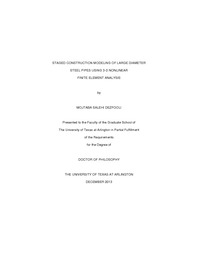
ATTENTION: The works hosted here are being migrated to a new repository that will consolidate resources, improve discoverability, and better show UTA's research impact on the global community. We will update authors as the migration progresses. Please see MavMatrix for more information.
Show simple item record
| dc.contributor.author | Salehi Dezfooli, Mojtaba | |
| dc.date.accessioned | 2016-01-28T18:03:52Z | |
| dc.date.available | 2016-01-28T18:03:52Z | |
| dc.date.submitted | January 2013 | |
| dc.identifier.other | DISS-12477 | |
| dc.identifier.uri | http://hdl.handle.net/10106/25562 | |
| dc.description.abstract | This study investigates the performance of large diameter steel pipes during stage construction. Using this study, metal pipes are designed utilizing existing native soil for embedment around the pipe rather than imported materials. This indeed, translates into a considerable amount of cost saving and advances in designing pipeline. This model is used for peer review/ designing of a 242 km (150 miles) pipeline project, Integrated Pipeline (IPL), that transports approximately hundreds of millions of gallons from Lake Palestine, 137 km (85 miles) southeast of Dallas, to Lake Benbrook, Tarrant County, Texas. The IPL project supplies water to more than1.8 million people living in 11 counties of North Texas. The results of this study not only benefits the Tarrant Regional Water District but also can be used in other projects.A comprehensive robust nonlinear finite element analysis model was developed and verified by four experimental tests which were conducted at the University of Texas at Arlington. The developed FEM model considered all three nonlinear algorithms including geometric, material, and contact nonlinearities. The developed FEM model considered the soil compaction which is an important force in staged construction modeling of the steel pipes. Also the geometric change of pipe during construction was modeled accurately for the first time to accurately obtain the behavior of the buried steel pipes. Four instrumented large diameter steel pipes, with the diameter of 1.83 m (72 in.), were placed in a 6.1 m (20 ft) wide rigid trench with different backfilling configurations. The promising results of the study indicated that the developed model successfully predicted the experimental tests. The developed FEM model was further modified then by incorporating flexible trench wall and other unique tools to be capable of modeling different pipeline designs. Moreover, the modified FEM model was used to verify three field tests which were conducted in Rolling Hills Booster Pump Station, in Fort Worth, Texas. The comparison of the results showed that the modified FEM model also successfully predicted the real field condition.Finally, a comprehensive parametric study was conducted by identifying the most common geometric and force related parameters for large diameter pipe-soil interaction systems. These parameters include but not limited to pipe geometric parameters, backfilling properties and type and level of compaction, and in-situ soil condition. The parametric study models were generated by using a Design Program (DP) which was developed specifically in this study to support the main FEM model analysis. The DP allows the designer to feed the developed FEM model with the required design parameters which will generate the FEM model in a fraction of time compared to conventional manual model development. The results of the parametric study then were used to develop series of design equations for moment, thrust, shear, and horizontal and vertical deflection of buried steel pipes as a function of independent variables which were comprehensively identified in parametric study. The developed equation will be a platform to be used in the steel pipe design manuals. | |
| dc.description.sponsorship | Abolmaali, Ali | |
| dc.language.iso | en | |
| dc.publisher | Civil & Environmental Engineering | |
| dc.title | Staged Construction Modeling Of Large Diameter Steel Pipes Using 3-D Nonlinear Finite Element Analysis | |
| dc.type | Ph.D. | |
| dc.contributor.committeeChair | Abolmaali, Ali | |
| dc.degree.department | Civil & Environmental Engineering | |
| dc.degree.discipline | Civil & Environmental Engineering | |
| dc.degree.grantor | University of Texas at Arlington | |
| dc.degree.level | doctoral | |
| dc.degree.name | Ph.D. | |
Files in this item
- Name:
- SalehiDezfooli_uta_2502D_12477.pdf
- Size:
- 70.82Mb
- Format:
- PDF
This item appears in the following Collection(s)
Show simple item record


